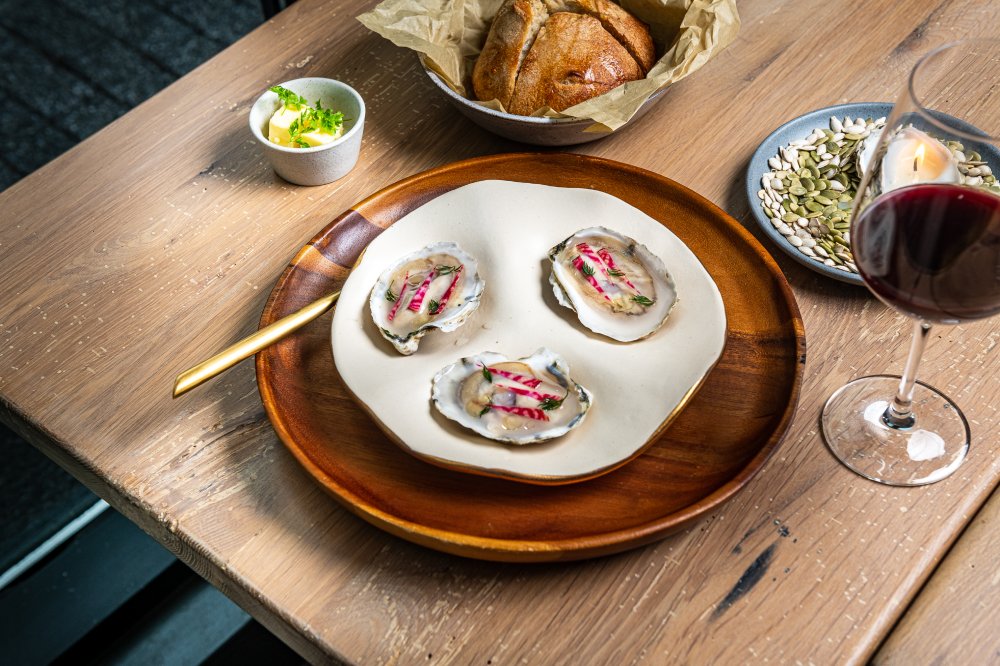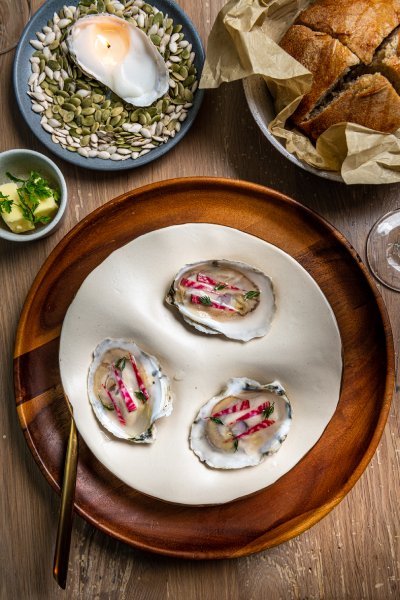Eat
 Oyster Oyster. Photo by Rey Lopez.
Oyster Oyster. Photo by Rey Lopez.
Where to Get Fresh + Sustainable Oysters in D.C.
September 12, 2023 @ 12:00pm
Local chefs work closely with oyster farmers to ensure conservation is at the core.
When you’re slurping down a briny oyster, there’s an unusual allure. The texture is unlike any other food we encounter on a daily basis, and its connection to the salty water seems visceral. There’s no dressing up an oyster — it looks just as it did in the water, still clinging to its shell.
Eating an oyster is an occasion, and it’s one that’s receiving a lot of attention. Ordering a dozen for the table makes a point that this meal is worth savoring. Look at any menu in D.C. right now and it’s clear others agree.
But they’re so much more than a mollusk that’s having a moment. Oysters are closely tied to the health of our waterways, and the chefs who are featuring them on their menus recognize the importance of education in addition to dining.
Chef Rob Rubba of Michelin-starred and vegetarian-focused Oyster Oyster features oysters in addition to his primary focus on produce.
“It’s rooted in sustainability,” he says. “It’s about supporting our region and working on conservation efforts, and being responsible when it comes to how we cook and why we cook for our communities.”
While their populations have dramatically diminished due to pollution and overharvesting, particularly in the Chesapeake Bay, there are signs that the oyster population is slowly climbing upwards. This is critical since oysters are filter feeders, and the bay, rivers, and other brackish and salt waterways rely on them to remove algae and keep the water clean. Continuing to build this population back up is a focus for the farmers and for the chefs that rely on them.
When Rubba looks at sourcing oysters, he focuses on farms that prioritize restorative practices, localization and flavor.
“Purchasing directly from the oyster farmer and having that relationship is essential and we get the freshest product that way,” he says. “We’re only working with mid-Atlantic farmers.”

Oyster Oyster. Photo by Rey Lopez.
Rubba is known to prepare oysters raw, pickled, smoked, cooked into sauces and even served in a silky purée. A far cry from the traditional saltines and hot sauce (which is a delicacy with its own regional merits).
Chef Reid Shilling of Shilling Canning Company sources oysters from the Chesapeake region, and he works closely with Orchard Point Oysters in the East Bay on the Eastern Shore, which tend to be a sweeter, less briny, smaller, yet full oyster.
“During the year the ‘salt line’ will move so water can be more or less salty, so the oysters will vary on salinity depending on the time of the year but for the most part Orchard Point stay pretty mild,” Shilling says.
Shilling gets into the technicalities of farming oysters, explaining that the premium oysters they source are raised in the nursery with constant handling and size grading for consistency and uniform size.
“Then it progresses to open water grow out. This is really big for us-the more open the water, the better as open water creates more fetch, which describes how much unobstructed open water the oysters are floating in.”
He says the more fetch there is, the more tumbling and flushing (how much water the oyster processes) occur. These are what produce a healthy, uniform oyster — a process most don’t consider when sitting down to a plate of them.
“This process creates a flatter and larger abductor muscle, like a scallop,” Shilling says. “The movement is like a constant core workout for the oyster.”
Meanwhile, at Blue Duck Tavern, diners are tasting sustainably grown oysters from the Puget Sound, whose Kumamotos are known for their clean sweetness, to crisp, cucumber-y Kusshi’s from Vancouver Island to Island Creeks from Duxbury Bay, Massachusetts. And this diversity of location speaks to the connection of the oyster to its provenance.
“Not only are you tasting the organism, which has its own unique flavor, texture and complexity, you’re also quite literally tasting a location,” says Andrew Cleverdon, chef de cuisine of Blue Duck. He explains that you’re taking in a part of the world, with its own salinity and minerality. “Oceanic terroir, if you will.”
Cleverdon focuses on simplicity and tasting the regional differences of the oysters, and he’s refined a mignonette sauce accompaniment that’s made from a housemade seawood vinegar and seasoned with scotch.
“It makes sense,” he says. “Seaweed comes from the same place as oysters, and foods from the same area often work well together. People love salt and vinegar. Scotch is complementary to the salinity and minerality while providing a comforting smokiness.”
He dresses each oyster with a splash of the sauce and it’s ready to slip off the shell.
But regardless of how you prefer your oysters served, it’s best to wash them down with a glass of Champagne and a reminder that conservation is what will keep these bivalves on our plates.
“It’s true that Champagne goes with everything but it’s especially true with oysters,” Cleverdon says. “Try Blanc de Blancs — it plays well with the minerality and creaminess of my favorite oysters.”
Sparkling paired with salinity and sustainability? That’s a combination that works for us.
Want to experience oysters for yourself this fall? Along with Oyster Oyster and Blue Duck Tavern, check out events including the 14th annual Oysterfest at Hank’s Old Town with all-you-can-eat oysters on October 1 or the Seascape Watercolor Class at Hank’s Old Town featuring local artist Marcella Kriebel, where you can learn to draw these muse-worthy mollusks.
Get way ahead on your calendar by putting DC on the Half Shell, hosted by the Chesapeake Bay Foundation at Union Market Dock 5, on your calendar for March 2024. And, of course, there’s the famed Oyster Riot at Old Ebbitt Grill November 17-18 with yacht rock, oysters and wine pairings.
Blue Duck Tavern: 1201 24th St. NW, DC; blueducktavern.com // @blueducktavern
Hank’s Old Town: 818 N St Asaph St. Alexandria, VA; hanksoysterbar.com/old-town // @hanksoysterbar
Old Ebbitt Grill: 675 15th St. NW, DC; ebbitt.com // @oldebbitt
Oyster Oyster: 1440 8th St. NW, DC; oysteroysterdc.com // @oysteroysterdc
Shilling Canning Company: 360 Water St. SE, DC; shillingcanning.com // @shillingcanningcompany
Want to know more about the best stalwart and latest food hotspots in the city? Join the District Fray community for exclusive access to neighborhood guides and recommendations. Become a member and support local journalism today.







